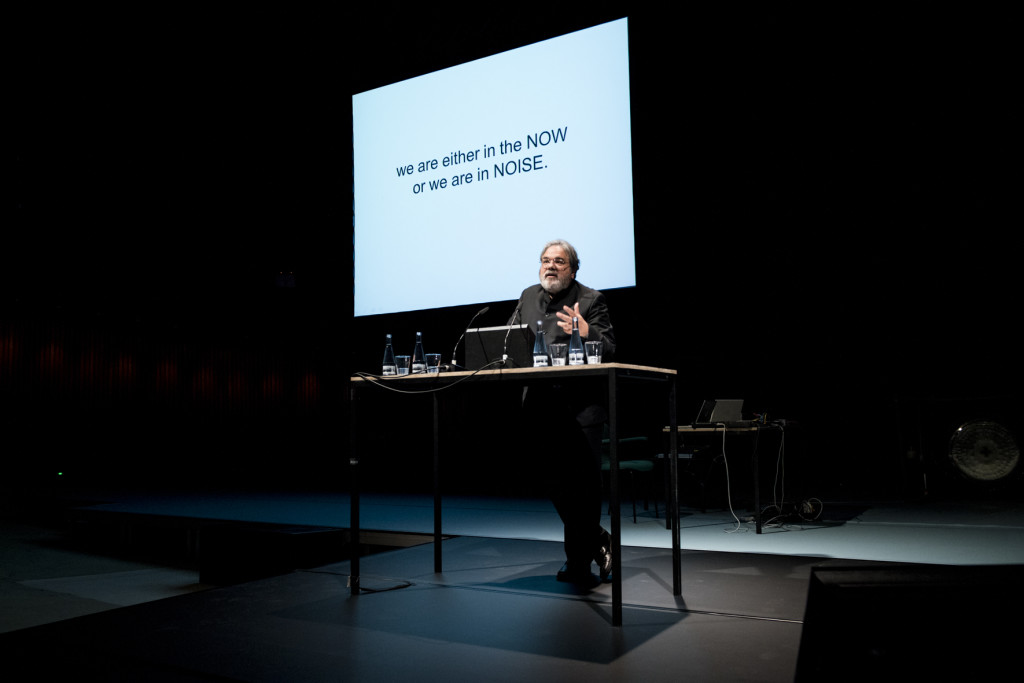The Greek god Caerus wears a long lock of hair over his forehead; the back of his head is shaven. Anyone who wanted to grab him by his famed forelock could only do so from the front; he could not be caught from behind. This makes him an outstanding figure of time, of the fleeting quality that we usually experience as lasting until we want to hold on to a moment. The name Caerus is from the ancient Greek word kairos meaning the opportune moment. In a statement for the opening of 100 Years of Now, the Norwegian cultural historian Helge Jordheim brought Caerus to mind to illustrate how one can only grasp time up to a certain point.
In contrast to Chronos, the other mythological being who became the epitome of the measurable time of chronometry, Caerus is an ambiguous being. Jordheim spoke of a contemporary culture of “presentism” that attempts to grab as much of the moment as possible while trying to make it malleable. The “now” thereby tends to lose its intensity, but it gains other qualities.
This constant veering, this polymorphism of time, was reflected at the opening of 100 Years of Now with its own focus: Time’s assault on the rest of life brought together musicians, scientists, historians and cultural theorists, all under one idea, “like an umbrella” (Hans-Jörg Rheinberger): In experimentation we get on the track of time in a particularly thorough way. Yet experimentation is not just the test set-up of natural sciences that recognize “shapes of time,” because materially, processes need a specific, sometimes barely perceptible duration of time in order to take place.
Experimentation can also be a musical improvisation or “comprovisation” as Sandeep Bhagwati called it, speaking not of “shapes” but of more ambiguous “specters of time.” Finally, experimentation can even be a global political maneuver, such as the annexation of Crimea, in which Helge Jordheim and political scientist Gwendolyn Sasse expound that various temporalities and spatial logics condensed and intersected.
In experimentation, time is made visible, the foundations of things are explored kairologically, as Evelina Domnitch and Dimitry Gelfand demonstrated in a lecture performance with music: the simultaneous observation of matter as both a particle and wave, a process – referring to the physicist Yves Couder – becomes accessible in musical form. But only up to a point, because “high speed is slow in music.” A musician or, as Sandeep Bhagwati said, a “musicker” creates a “living sense of now.”
The ability to store not just the music and lectures, but also the accompanying discussions in a media archive adds an extra dimension to the debates. The dramaturgy of individual evenings or events can now be accessed individually and then rearranged. For example, we can correlate Chinese poets such as Guo Jinniu – whose idea of time is characterized by ancestral beliefs as well as the extreme Taylorism of high-tech sweatshops – with a composed British political scientist and historian like Gwendolyn Sasse who points out that the Crimea has always been a region of at least three temporalities: a Russian, a Tatar and a Ukrainian – and one could add an Ottoman or Greek one too.
Sasse used the interesting term “path dependency,” about which one would have liked to consult the historical epistemologist Hans-Jörg Rheinberger. For there’s one thing time cannot do: It cannot deviate from the “path” that is materially given, and analogously, history constantly creates facts from which it then becomes dependent in its further progress.
Condensing 100 Years of Now to a heterogeneous, four-year major event is itself probably something of an “extension of the now,” which in its individual events applies to itself the principle of acceleration and deceleration, which Rheinberger designated as paradigmatic for experimentation. The experiment thus becomes a cultural event-model in itself. One no longer expects finished, rehearsed performances, let alone premieres. Instead, to eventually take up an idea put forward by Helge Jordheim, a single image can contain a whole space, which then unfolds in its historical and temporal linearity.
Depicting the entire, huge, geopolitical space “between Berlin and Beijing” may require a more significant image than a world map; for example, Greek ruins in “Russian” Crimea, as the artist collective Slavs and Tatars suggests. This idea can serve as a kind of motto for 100 Years of Now: the image as a slice of time, which creates simultaneity and defeats or reinforces identities. The image as a medium that throws the forelock to the front. Plus a musickal comprovisation. The “rest of life” takes on the assault of time experimentally and gains in presence of mind as a result.
